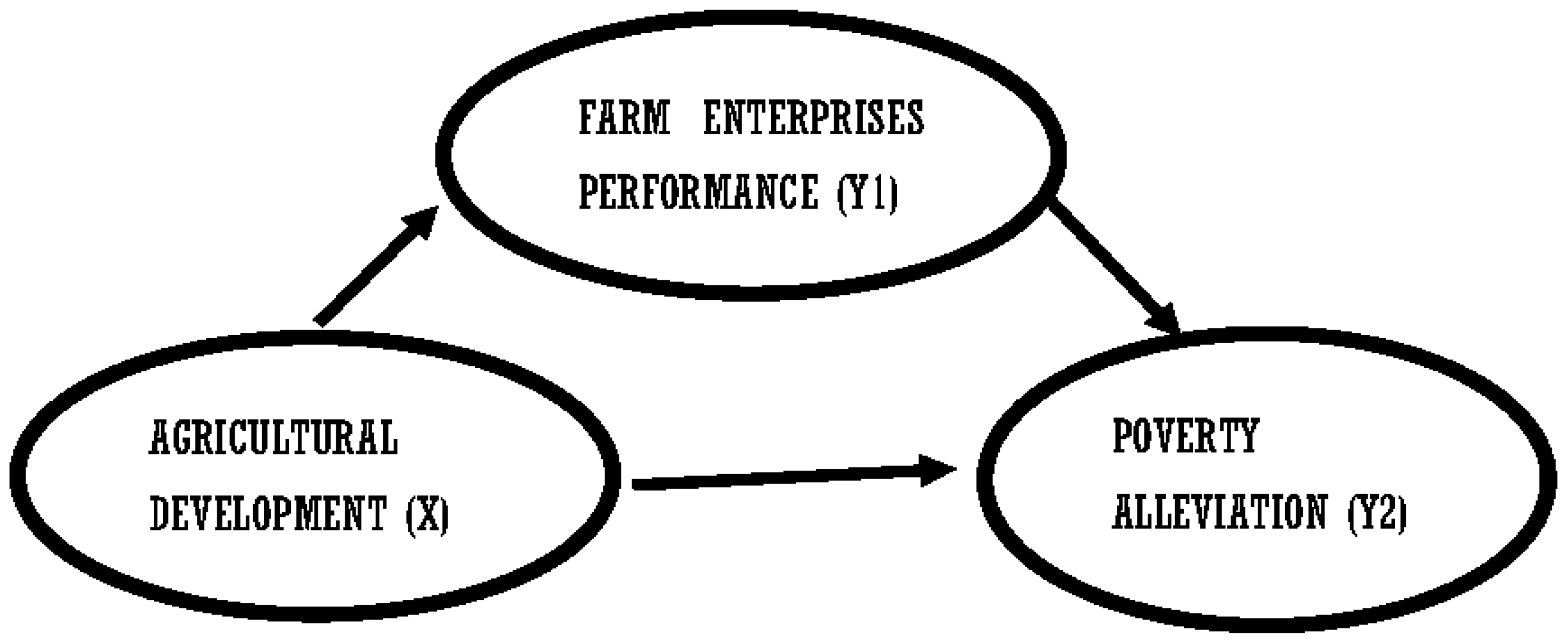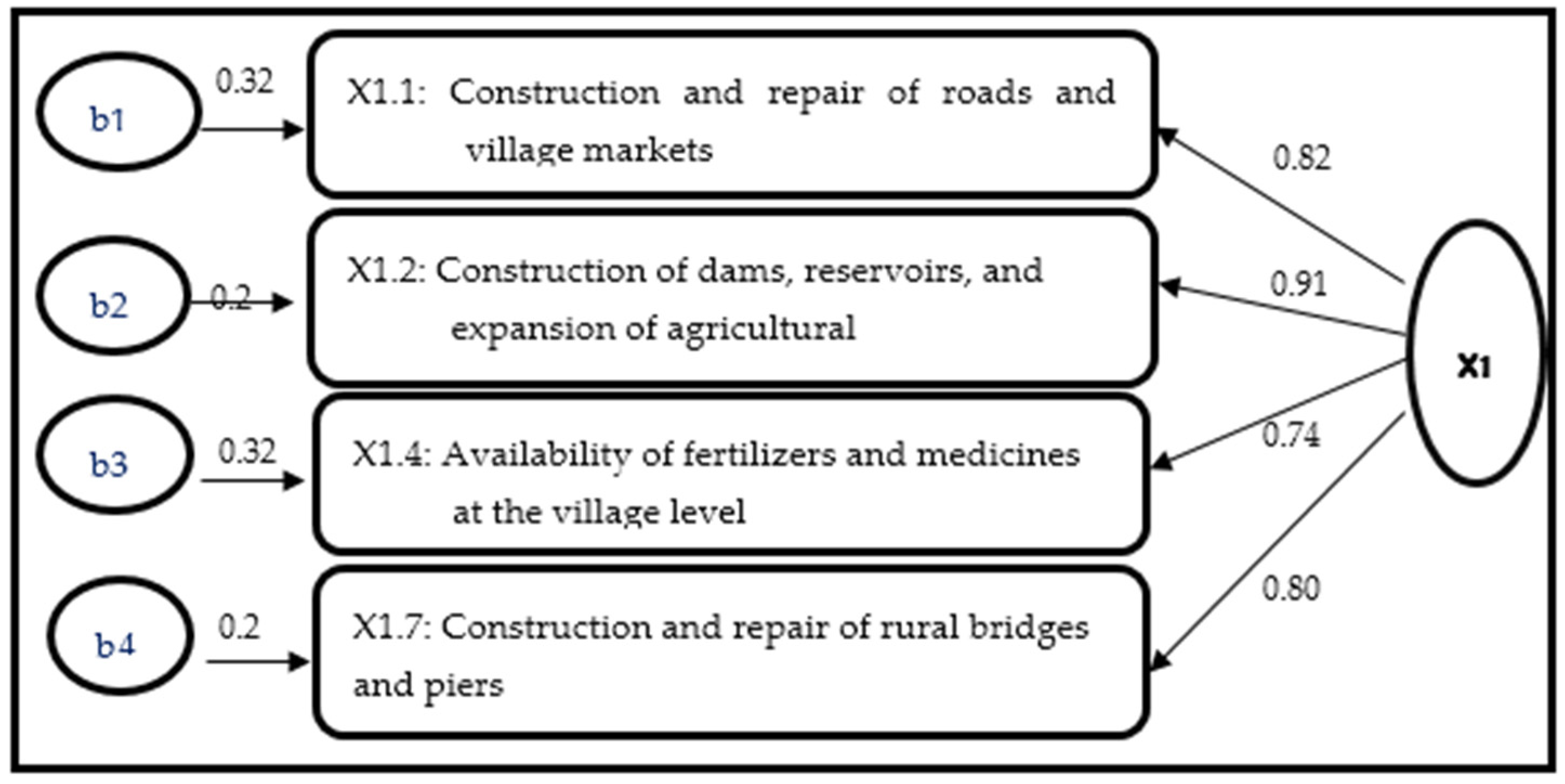1. Introduction
Government agencies have implemented poverty reduction initiatives, but poverty in the North Buton Regency still exists. This is because the policies have not been influential enough to reduce poverty.
Murdiansyah (
2014) claimed that poverty reduction might be influenced by reliance on macroeconomic growth, charity, inattentiveness to the indicators, poverty characteristics, and a lack of sustainability in implementing policy centralization and uniformity.
The Statistics Central Bureau stated that the population of the North Buton Regency in 2019 was 62,197 people, of which 14.26% were poor. This causes the regency to have the highest percentage of poor people in Southeast Sulawesi Province. The statistical data showed that poverty is an acute problem. This necessitates a faster and more appropriate approach to poverty alleviation in the regency. One of the poverty reduction program strategies is rural agricultural development. Most poor people live in rural areas, with their income coming mainly from the agricultural sector and other traditional economic activities (
Bappeda Buton Utara 2019).
The North Buton Regency has 6 districts, 59 villages, 8 sub-districts, and 3 transmigration settlement units. A total of 62,088 people mostly work as subsistence farmers in the food crops, plantations, and traditional fishing sub-sectors. Potential resources for non-irrigated rice fields, gardens, and fields are 2332 ha, 15,279 ha, and 14,894 ha, respectively, while 10,321 ha are uncultivated (
Bappeda Buton Utara 2019). Moreover, the agricultural land is fertile, and the work ethic of farmers is high. Based on data related to the potential of agricultural resources and most of the population living as farmers, agricultural development is necessary to increase its production and farmers’ income, as well as lift the population out of poverty.
The infrastructure development of roads, bridges, docks, and village markets is insufficient. Farmers cannot increase production, which is limited to the sub-district area. Furthermore, external economic forces are not included, the community’s economy is limited to production, and the technology used is traditional. The system for implementing business activities is traditional subsistence, because farmers lack farming skills. Therefore, the production, quality, and selling prices reduce the farmers’ income and increase poverty.
Infrastructure facilitates the marketing of agricultural production, fertilizers, and medicines to increase farm productivity. It also facilitates the accessibility of field agricultural extension workers (PPL) in fostering and training farmers to improve their farming skills, increasing their production and work ethic. Moreover, infrastructure facilitates the farm laborers’ accessibility, enabling farmers to obtain labor from land processing to post-harvest to increase agricultural productivity in rural areas. It also enhances the marketing of agricultural production at high selling prices and the low cost of transporting its products to the marketing center. This increases farmers’ income and economic growth in rural areas.
Robbins and Coulter (
2016) stated that strengthening farmer resources increases ability, promotes willingness, and makes farmers independent in improving their farming performance. According to
Sedarmayanti (
2017), farmer empowerment improves the ability to carry out farming business, developing its infrastructure facilities and easy access to knowledge, technology, and information; strengthening farmer institutions; and increasing production. As a result, it increases farmers’ income and tackles poverty in rural areas.
Hasan et al. (
2017) showed that agricultural land in the rural area of the North Buton Regency is fertile, with indicators that without fertilization, it could produce a high production. Farmers have a high work ethic, indicating that they work about 8–10 h daily on the farm. The production, quality, and selling price of agricultural production are low, reducing farmers’ income and increasing poverty. This contradicts the economic theory, which states that when the land for farming is fertile and the farmers’ work ethic is high, agricultural productivity and farmers’ income increase (
Todaro and Smith 2015).
Karimuna et al. (
2009) showed that agricultural productivity growth in rural areas in the North Buton Regency has a large role for conventional input factors. For instance, land, labor, and livestock, which optimize conventional input factors, increase rural farmers’ income. Modern input factors, such as machinery, advanced chemical technology, and genetics, increase agricultural productivity insignificantly. This finding contradicts
Rozelle and Swinnen (
2004), who stated that the development of innovation and modern technology increases agricultural productivity and farmers’ income. Furthermore, agricultural technology promotes the improvement of welfare and alleviates the poverty of the rural population.
Soraya (
2018) showed that rural farmers in the North Buton Regency have actual and potential resources related to ownership of an institutional relationship network, friendship, and mutual sympathy. They also have relations forming a social work group, such as cooperation in the agricultural sector and a high farmer work ethic. However, the social capital built from community culture has not impacted agricultural productivity and rural farmers’ income. This contradicts the sociological theory of agriculture that social and cultural aspects have economic value that could be institutionalized based on mutual knowledge and recognition. It is the ability to work together to face problems and achieve group goals that results in increasing agricultural productivity and the rural farmers’ income (
Coleman 1998;
Syahra 2003).
The vital role of agricultural development in the North Buton Regency was shown by its 29.64% contribution to the Gross Domestic Product (GDP) in 2019. The agricultural sector employed 42.52% of labor in the same year. These facts are in line with
Edward and Sumner (
2015), who stated that agricultural development creates opportunities, boosts income generation, and alleviates rural poverty. Therefore, this study aimed to determine:
The influence of agricultural development on improving farming performance in the North Buton Regency,
The influence of agricultural development on rural poverty alleviation in the North Buton Regency, and
How the increase of farming performance alleviates rural poverty in the North Buton Regency.
Many studies were conducted on agricultural development in Indonesia (
Christiansen et al. 2011), but none linked farm enterprises’ performance to agricultural development for poverty alleviation. Therefore, this study contributes significantly to literature in this field. The variables of agricultural development, farm business performance, and poverty alleviation were measured using a subjective approach (
Cummins 2000).

















